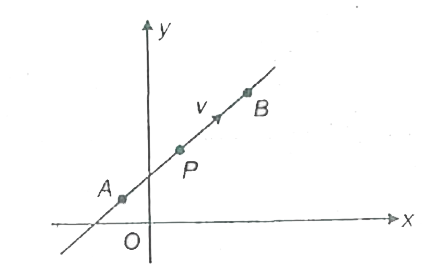A particle having mass 2 kg is moving along straight line 3x+4y=5 with speed 8m/s . Find angular momentum of the particle about origin, x and y are in meters.
The correct Answer is:16kgm2/s
To find the angular momentum of a particle about the origin, we follow these steps:
Step 1: Determine the equation of the line and its parameters
The line given is 3x+4y=5. We can rearrange this into slope-intercept form to find the slope and y-intercept:
y=−34x+54
Step 2: Find the perpendicular distance from the origin to the line
The formula for the perpendicular distance d from a point (x0,y0) to a line Ax+By+C=0 is given by:
d=|Ax0+By0+C|√A2+B2
For our line, we can rewrite it as:
3x + 4y - 5 = 0 \quad \text{(where A = 3,B = 4,andC = -5)}
Substituting the origin (0,0):
d=|3(0)+4(0)−5|√32+42=5√9+16=55=1 meter
Step 3: Calculate the linear momentum of the particle
The linear momentum p of a particle is given by:
p=mv
Where m=2kg and v=8m/s:
p=2kg×8m/s=16kg m/s
Step 4: Calculate the angular momentum about the origin
The angular momentum L about a point is given by:
L=r×p
Where r is the perpendicular distance from the point to the line (which we found to be 1 meter) and p is the linear momentum:
L=d⋅p=1m×16kg m/s=16kg m2/s
Final Answer
The angular momentum of the particle about the origin is:
16kg m2/s
---
The line given is 3x+4y=5. We can rearrange this into slope-intercept form to find the slope and y-intercept:
y=−34x+54
The formula for the perpendicular distance d from a point (x0,y0) to a line Ax+By+C=0 is given by:
d=|Ax0+By0+C|√A2+B2
For our line, we can rewrite it as:
3x + 4y - 5 = 0 \quad \text{(where A = 3,B = 4,andC = -5)}
Substituting the origin (0,0):
d=|3(0)+4(0)−5|√32+42=5√9+16=55=1 meter
The linear momentum p of a particle is given by:
p=mv
Where m=2kg and v=8m/s:
p=2kg×8m/s=16kg m/s
The angular momentum L about a point is given by:
L=r×p
Where r is the perpendicular distance from the point to the line (which we found to be 1 meter) and p is the linear momentum:
L=d⋅p=1m×16kg m/s=16kg m2/s
The angular momentum of the particle about the origin is:
16kg m2/s
Topper's Solved these Questions
- BOOK - MOTIONCHAPTER - 10 ROTATIONALEXERCISE - Exercise - 3 (Level - II)20videos
10 ROTATIONAL
- BOOK - MOTIONCHAPTER - 10 ROTATIONALEXERCISE - Exercise - 4 (Level - I)24videos
10 ROTATIONAL
- BOOK - MOTIONCHAPTER - 10 ROTATIONALEXERCISE - Exercise - 2 (Level - II)25videos
10 ROTATIONAL
- BOOK - MOTIONCHAPTER - ALTERNATING CURRENTEXERCISE - EXERCISE - 4 (LEVEL - II)14videos
ALTERNATING CURRENT
Similar Questions
Knowledge Check
- Question 1 - Select One
A particle of mass 1kg is moving alogn the line y=x+2 with speed 2m/sec. The magnitude of angular momentum of the particle about the origin is
A4kg−m2/secB2√2kg−m2/secC4√2kg−m2/secD2kg−m2/sec - Question 2 - Select One
A particle of mass 1 kg is moving along the line y=x+2 (here x and y are in metres) with speed 2m/s. The magnitude of angular momentum of paticle about origin is -
A4kg−m2/sB2√2kg−m2/sC4√2kg−m2/sD2kg−m2/s - Question 3 - Select One
A particle of mass 1 kg is moving along the line y = x + 2 (here x and y are in metres) with speed 2 m/s. The magnitude of angular momentum of particle about its origin is
A4kgm2s−1B2√2kgm2s−1C4√2kgm2s−1D2kgm2s−1
A particle of mass 300 g is moving with a speed of 20 ms−1 along the straight line y = x - 4√2. The angular momentum of the particle about the origin is (where y & x are in metres)
View SolutionA particle of mass m is moving along the line y=b,z=0 with constnat speed v. State whether the angular momentum of particle about origin is increasing. Decreasing or constant.
View SolutionA particle mass 1 kg is moving along a straight line y=x+4. Both x and y are in metres. Velocity of the particle is 2m/s. Find the magnitude of angular momentum of the particle about origin.
View SolutionA particle of mass m is moving on the XY-plane along a straight line y = d, with constant velocity v. Its angular momentum about the origin
View SolutionA particle P is moving along a straight line as shown in the figure. During the motion of the particle from A to B the angular momentum of the particle about O
 View Solution
View Solution

